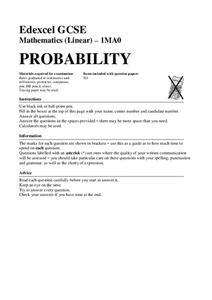Curated OER
Scale of the Galaxy
The fourth of five videos deals with the scale and the relative distances between planet, stars, and other galactic bodies.
PBS
Graffiti Art: Supplies
Just how much spray paint does a mural require? Using proportions, graffiti artists determine the amount of supplies needed to complete a mural. The creative resource shows how to determine the area of composite figures and uses that...
TED-Ed
How Long Will Human Impacts Last?
If aliens visit Earth a million years from now, what will they find? Explore the Anthropocene epoch with a hard-hitting video. Viewers examine the changes humankind has made to the planet, how these overshadow events of the past, and...
Crash Course
The Big Bang: Crash Course Big History #1
Theoretical physicists say that space and time are one thing created by the Big Bang. According to them, nothing happened in the time before the Big Bang because time did not exist. The first Crash Course-Big History video in a 16-part...
Socratica
Chemistry: What Is a Covalent Bond? (Polar and Nonpolar)
When it comes to covalent bonding, sharing is caring! As part of the Socratica chemistry playlist, a useful video explains the definition of covalent bonding. Then, it works through examples of single bonding, double bonding, polar...
Corbett Maths
Enlargements Using Ray Method
Figure out what to do when there is no grid to count. Using a ruler and a sharp pencil, the narrator shows how to perform a dilation when the figure is not on a grid. The ray method works by drawing a ray from the center of dilation...
Crash Course
Mathematical Thinking: Crash Course Statistics #2
What is the probability that someone will draw the same lottery numbers two times in a row? Very small, but it can—and has—happened! Statisticians often work with very large or small numbers. The second lesson in a statistics playlist...
Math Antics
Proportions
Equivalent ratios lead to proportions. The video provides the definition of a proportion and provides examples of proportions. Using real-world examples, the resource shows how to solve for unknown quantities in proportions using the...
Curated OER
Anatomy of a Muscle Cell
Previous videos have dealt with the proteins that produce mechanical motion and how nerves stimulate contraction. But this presentation explains on a gross anatomical scale, how skeletal muscle is structured.
MinutePhysics
This is Not a Rainbow
A color-based video explains how scientists identified the colors of the rainbow and why we see different colors at different times. It introduces the idea of supernumerary colors and the disc shape of a rainbow as well.
Mathed Up!
Probability
How likely is it to draw a blue marble? Pupils find the likelihood of events and connect that to the probability of the event. They find the probabilities of simple events and show their probabilities on a scale.
Curated OER
Parallax in Observing Stars
Parallax is the apparent change of an object determined by the line of sight. Sal defines the concept of parallax and applies it to how we determine the relative distance between us and near-by stars. He draws a diagram to illustrate...
Bozeman Science
Graphing Data By Hand
We have calculators, so why do we have to do this by hand? The video takes viewers through graphing scientific data by hand to create a scatter plot. The process includes labeling axes, writing an appropriate title, determining a scale,...
Krista King Math
Nets of Cones
Use a net to catch your classes in the process of learning! A video instruction demonstrates how to draw the net of a three-dimensional cone. The nets include scale and labeling of dimensions.
Domain of Science
The Map of Chemistry
Many people study for years to understand even a subsection of chemistry, yet an informative video attempts to cover all of chemistry in 12 minutes. It starts with atoms and elements and moves through bonding, reactions, energy, and...
PBS
When Fish Wore Armor
Today very few animals exist with both an endoskeleton and exoskeleton. Yet, in the Devonian period, a large number of fish species lived with both. Scientists debate if they were for protection or mineral storage, because none of them...
Khan Academy
Hubble's Law
Sal defines and explains the premise of Hubble's Law and then uses trigonometry to show the relationship between velocity and distance. He explains that as the universe expands, objects get farther away from each other; as objects move...
Curated OER
Red Shift
The Red Shift concept can be one of the most confusing in physics. Learners may find it helpful to start with learning more about the Doppler Effect before introducing this video.
Curated OER
Multiplying Fractions and Mixed Numbers
Here is a great video explaining how to multiply a fraction by a whole number. Sal shows students how to put a whole number over 1 in order to multiply it by a fraction. He simplifies his answer and writes it as a mixed number.
Curated OER
Systems of Three Variables 2
Sal uses the elimination method to simplify a system of three variables. Next, he employs the substitution method to check his solution. This resource would nicely complement any lesson on this topic.
Curated OER
Structure of the Earth
Salman Khan goes into detail about the layers of the Earth. He provides names and general numbers about depths and composition.
Other popular searches
- Construct Scale Drawings
- Drawing to Scale
- Scale Drawing Projects
- Blueprints and Scale Drawing
- Maths and Scale Drawing
- Scale Drawing Bedroom
- Scale Drawing on Grid
- Scale Drawings and Maps
- Interactive Scale Drawing
- Creating Scale Drawings
- Lesson Ideas Scale Drawing
- Scale Drawings and Models






















